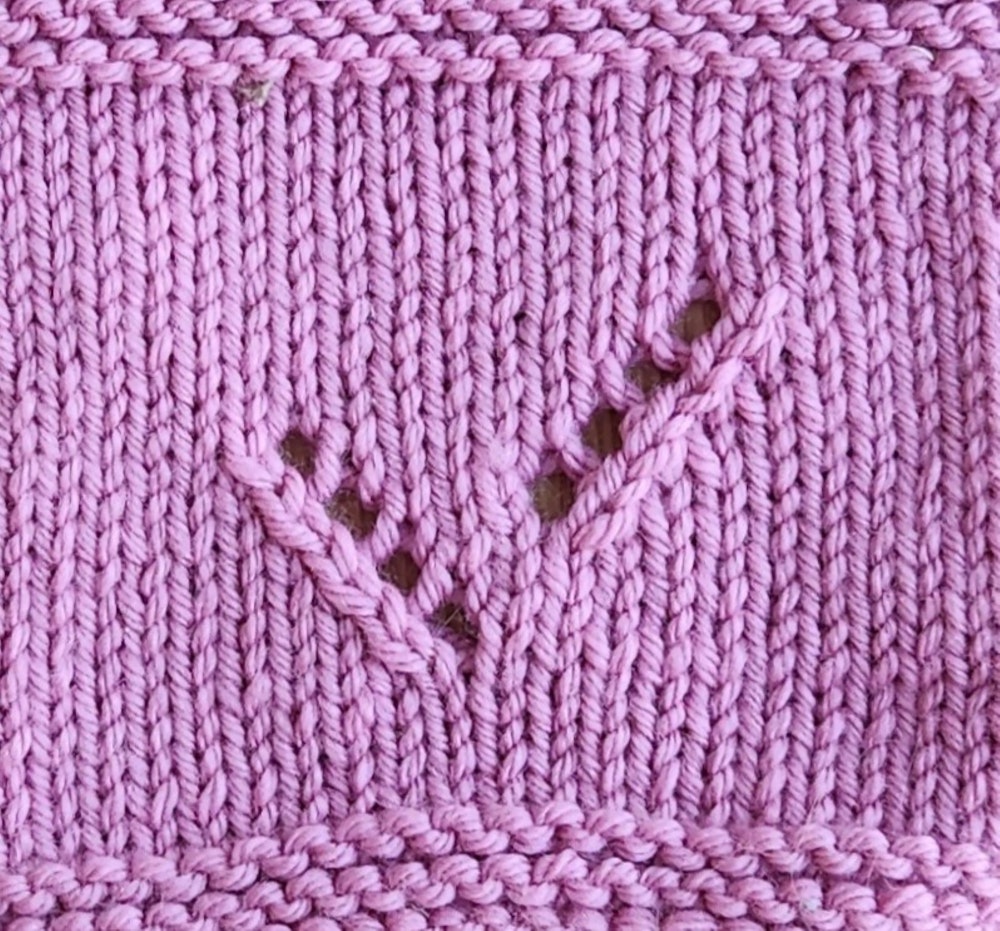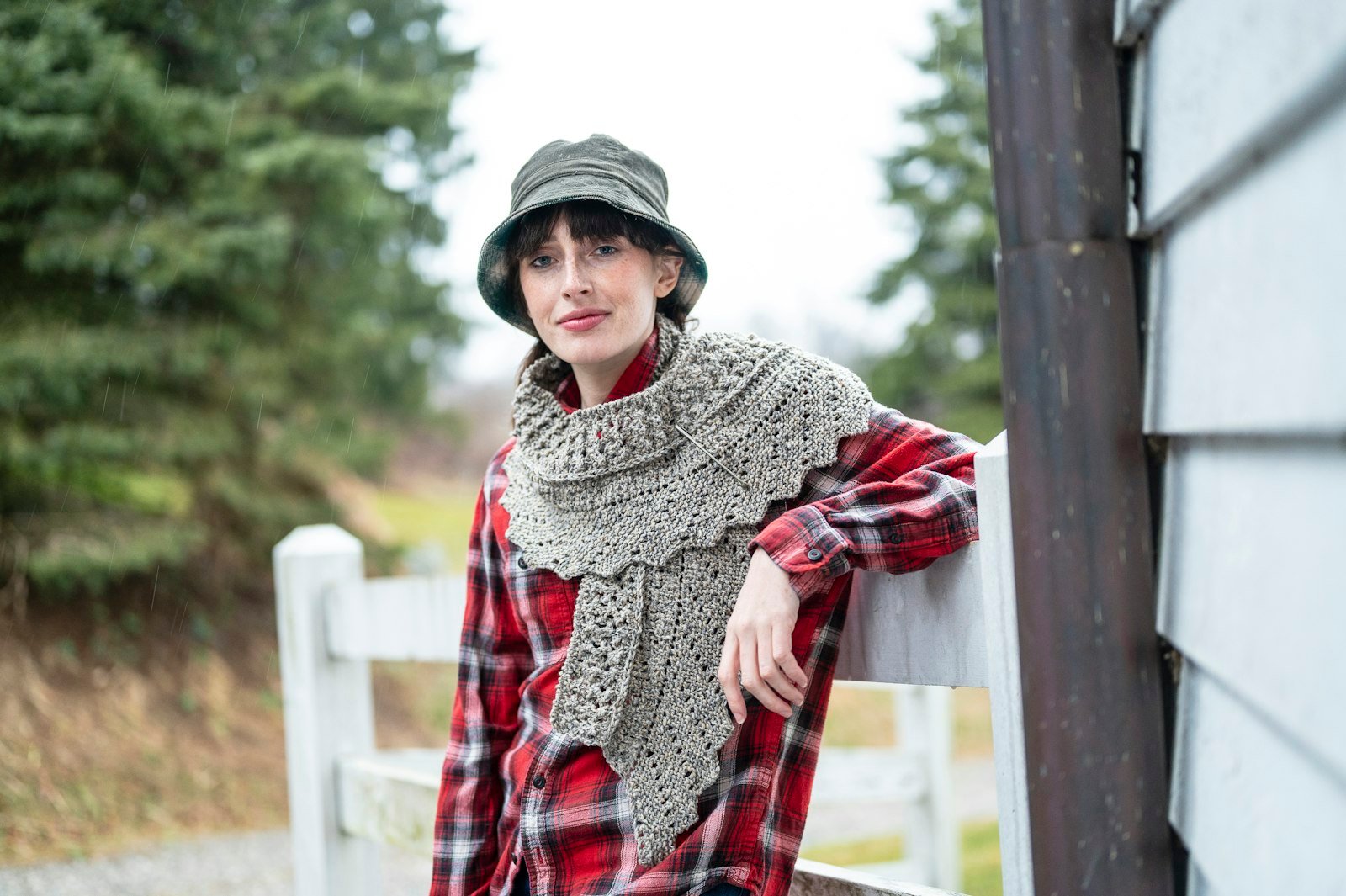Sometimes in knitting, as in life, we overlook simple elegance in pursuit of more complicated things. Consider the humble eyelet. Eyelets are nothing more than holes intentionally created in knitted fabric. They are simple to work, and are an easy way to add visual interest to your knitting. Just look at the effect they have in the Grand Picot Chunky Scarf, designed by Lori Steinberg, which showcases lines of eyelets in the body of the scarf as well as in the sawtooth edging.
The term “eyelet” comes from the French for “little eye” —although I prefer not to visualize them as tiny eyes! Most often, eyelets are decorative, although they can be functional: you can weave ribbons or cords through the eyelets in a piece of knitting. Eyelets make very nice small buttonholes, too.
Creating Holes on Purpose
To make an eyelet in knitting, you pair a yarnover (which creates a hole) with a decrease (which maintains the stitch count). Perhaps the most common version of an eyelet commences with a yarnover (bring the working yarn to the front, then over the needle), followed by knit 2 together (k2tog).
You can also work an eyelet using another type of decrease, such as SSK (slip, slip knit) or SKP (slip, knit, pass slipped stitch over). As with the k2tog version, you will work a yarnover first and then the SSK or SKP. Remember that k2tog is a right-leaning decrease, while SSK or SKP is a left-leaning increase. You can see the way each decrease leans in the swatch below. The lines created by the two different methods don’t match, so a designer generally opts for one or the other or intentionally lines them up for a decorative effect, as in the swatch below.
 Pairing a left-leaning decrease with a yarnover creates the eyelets (left) to veer to the left, and right-leaning decreases paired with a yarnover create eyelets (right) that tilt to the right. Photos courtesy of the author unless otherwise noted
Pairing a left-leaning decrease with a yarnover creates the eyelets (left) to veer to the left, and right-leaning decreases paired with a yarnover create eyelets (right) that tilt to the right. Photos courtesy of the author unless otherwise noted
It is easy to add a row of eyelets to plain stockinette or garter stitch. Here are examples of both— you can see how the flatter surface of stockinette stitch allows the eyelets to pop more, while the denser rows of garter stitch make less prominent holes.
 A single row of eyelets creates visual interest against a field of stockinette.
A single row of eyelets creates visual interest against a field of stockinette.
 Eyelets inserted into garter stitch create a subtler effect given the density of the stitch.
Eyelets inserted into garter stitch create a subtler effect given the density of the stitch.
Eyelets are made up of multiples of two stitches (two stitches are knitted together to become one stitch, and the yarnover creates the second stitch). You can work eyelets one after another all the way across a row, without extra stitches separating them, or you can space them out however you please. Rows of horizontal eyelets are fun to work, and they add a graceful effect across your knitted work. Lori Steinberg’s scarf uses sweeping horizontal eyelets as one of its design features— lovely!
 Note the clever way that eyelets are used to outline different design elements in the Grand Picot Chunky Scarf. Photo by Gale Zucker
Note the clever way that eyelets are used to outline different design elements in the Grand Picot Chunky Scarf. Photo by Gale Zucker
You can also create columns of eyelets by working them on subsequent rows directly on top of each other. To achieve eyelets that maintain their shape, work three or more plain rows (without eyelets) after the first eyelet row, ending on a wrong-side row. The intervening plain rows help keep the eyelet from turning into a more elaborate mesh-type stitch.
The second eyelet of a simple eyelet column will generally be worked on a right-side row. Columns of eyelets create a nice visual contrast to the horizontal lines of self-striping or morphing yarns. They are also stunning when placed on the diagonal.
As knitting expert Mary Thomas observed, the eyelet is “the most ornamental unit in knitting and can be grouped in almost any geometric or floral shape.” Clever knitters have created countless patterns using eyelets, everything from animals to flowers to geometric designs and more. Make a swatch or even a lace sampler to try out different ideas. You can start with simpler horizontal or diagonal lines or go wild and create your own shapes by plotting a design on knitting graph paper. The next time you’d like to liven up some plain knitting, remember the humble eyelet. Whether stacked in columns or running in rows, eyelets are a fun and easy way to add some pizzazz!
Carol J. Sulcoski is a knitting author, designer, and teacher. She’s published seven knitting books, including Knitting Ephemera, which is full of knitting facts, history, and trivia. Her articles have appeared in publications such as Vogue Knitting, Modern Daily Knitting, Noro Magazine, the Craft Industry Alliance website, and others. She lives outside Philadelphia and teaches at knitting events, shops, and guilds. Her website is blackbunnyfibers.com.

